Object Record
Images
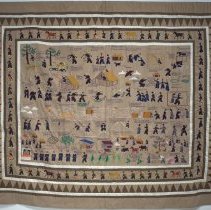

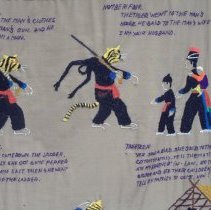
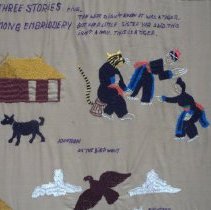

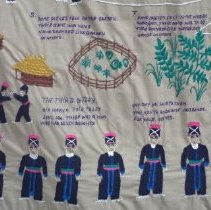
Additional Images [1]
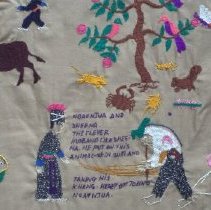
Metadata
Artist |
Unknown |
Nationality or Tribal Affiliation |
Hmong |
Title |
The Three Stories of Hmong Embroidery |
Type of Object |
Needlework |
Date |
1970s |
Medium |
Cotton/Thread |
Dimensions |
H-187.2 W-229.9 cm |
Collection |
Missoula Art Museum Collection |
How acquired |
Gift of Jean and Lon Homeier |
Object ID |
2010.05 |
Statement about this object |
This cloth relates three traditional Hmong stories in embroidered words and images. The stories and figures are very similar to another story cloth of legends, MAM Collection Object ID 2011.10.01. The first, shown across the top of the panel, is "The Woman and the Tiger." A tiger killed a family and dressed up as one of the men. The wife's sister, named Yer, fought back again and again. Her brothers set a trap, killed the tiger, and rescued Yer. The second story, which starts at the center right and continues from the left through the middle of the cloth, is called "The Flood How Hmong Names Began." A sister and brother escape from a flood, marry (against the sister's judgment), and have a stone-like baby. They scatter the baby's parts, which take root and become the major Hmong families of Vang, Thao, Li, and Moua. The third story is actually "Six Hmong Folk Tales" and runs along the bottom of the panel. The images include the king and his seven daughters, plants that harvest themselves, corn and rice choking out other plants, and Naoanjua and Sheena playing the qeej ("kheng") and cooking. The neutral colors and large scale of this flower cloth indicate it was made in a Thai refugee camp with the intent to sell (it was purchased from Hmong in Missoula). Missionaries provided blue, gray, and tan fabrics were not part of the traditional Hmong color palette. Women began sewing larger cloths in the camps, since their agrarian lifestyle was displaced and they were no longer confined to sew after farm chores were complete. Relatives who had relocated oversees also sparked new interest from Western buyers, and embroiderers in the camps would export their cloths to generate additional income. |
Subjects |
Legends Text Hmong Family Animals Animals in human situations Rescues Floods Creation Farming Agriculture Qeeg (musical instrument) |

